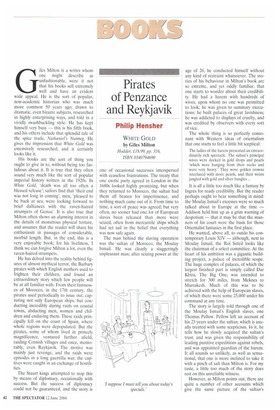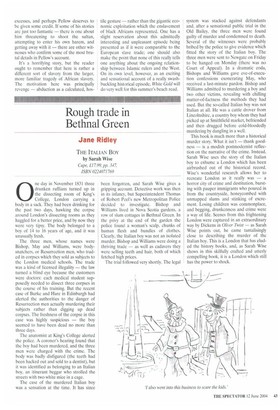Pirates of Penzance and Reykjavik
Philip Hensher
WHITE GOLD by Giles Milton Hodder, £18.99, pp. 316, ISBN 0340794690 Giles Milton is a writer whom one might describe as unfashionable, were it not that his books sell extremely well and have an evident wide appeal. He is the sort of popular, non-academic historian who was much more common 50 years ago; drawn to dramatic, even bizarre subjects, researched in highly enterprising ways, and told in a vividly swashbuckling style. He has kept himself very busy — this is his fifth book, and his others include that splendid tale of the spice trade, Nathaniel's Nutmeg. He gives the impression that White Gold was extensively researched, and it certainly looks like it.
His books are the sort of thing you ought to give in to, without being too fastidious about it. It is true that they often sound very much like the sort of popular imperial history written in the 1920s. In White Gold, 'death was all too often a blessed release'; sailors find that 'their end was not long in coming'; men, 'pleased to be back at sea, were looking forward to brief dalliances with the raven-haired strumpets of Genoa'. It is also true that Milton often shows an alarming interest in the details of monstrous physical torture, and assumes that the reader will share his enthusiasm in passages of considerable, morbid length. But, in the end, this is a very enjoyable book; for his liveliness, I think we can forgive Milton a lot, even the raven-haired strumpets.
He has delved into the reality behind figures of almost mythical terror, the Barbary pirates with which English mothers used to frighten their children, and found an extraordinary story which few people will be at all familiar with. From their fastnesses of Morocco, in the 17th century, the pirates used periodically to issue out, capturing not only European ships, but conducting incredibly daring raids on coastal towns, abducting men, women and children and enslaving them. These raids principally fell on the coast of Spain, where whole regions were depopulated. But the pirates, some of whom lived in princely magnificence, ventured further afield, raiding Cornish villages and once, memorably, even Reykjavik. The motive was mainly just revenge, and the raids were episodes in a long guerrilla war; the captives were caught in an exchange of hostilities.
The Stuart kings attempted to stop this by means of diplomacy, occasionally with success. But the success of diplomacy could not be guaranteed, and the story is one of occasional successes interspersed with ceaseless frustrations. The treaty that one exotic party agreed in London in the 1680s looked highly promising, but when they returned to Morocco, the sultan had them all beaten for impertinence, and nothing much came out of it. From time to time, a sort of peace was agreed; but very often, no sooner had one lot of European slaves been released than more were seized, often from mercantile ships which had set sail in the belief that everything was now safe again.
The man behind the slaving operation was the sultan of Morocco, the Moulay Ismail. He was clearly a staggeringly unpleasant man; after seizing power at the age of 26, he conducted himself without any kind of restraint whatsoever. The stories of his behaviour in Milton's book are so extreme, and yet oddly familiar, that one starts to wonder about their credibility. He had a harem with hundreds of wives, upon whom no one was permitted to look; he was given to summary executions; he built palaces of great lavishness; he was addicted to displays of cruelty, and was credited by observers with every sort of vice.
The whole thing is so perfectly consonant with Western ideas of orientalism that one starts to feel a little bit sceptical:
The ladies of the harem presented an extraordinarily rich spectacle. The sultan's principal wives were decked in gold drops and pearls 'which were hanging from their necks and were very heavy.' They wore golden crowns interlaced with more pearls, and their wrists jangled with gold and silver bangles ...
It is all a little too much like a fantasy by Ingres for ready credibility. But the reader perhaps ought to bear something in mind: the Moulay Ismail's excesses were so much talked about in Europe at the time — Addison held him up as a grim warning of despotism — that it may be that the manners of his court were the basis for those Orientalist fantasies in the first place.
He wanted, above all, to outdo his contemporary Louis XIV — although, next to Moulay Ismail, the Roi Soleil looks like the chairman of a select committee. At the heart of his ambition was a gigantic building project, a palace of incredible scope. The huge complex of palaces, of which the largest finished part is simply called Dar Kbira, The Big One, was intended to stretch for 300 miles, from Meknes to Marrakesh. Much of this was to be achieved with the help of European slaves, of which there were some 25,000 under his command at any time.
The story is largely told through one of the Moulay Ismail's English slaves, one Thomas Pellow. Pellow left an account of his 23 years under the sultan, which is usually treated with some scepticism. In it, he tells how he slowly acquired the sultan's trust, and was given the responsibility of leading punitive expeditions against rebels, and was appointed guardian of the harem. It all sounds so unlikely, as well as sensational, that one is more inclined to take it with a pinch of salt than Milton is. For my taste, a little too much of the story does rest on this unreliable witness.
However, as Milton points out, there are quite a number of other accounts which give the same picture of the sultan's excesses, and perhaps Pellow deserves to be given some credit. If some of his stories are just too fantastic — there is one about him threatening to shoot the sultan, attempting to enter his own harem, and getting away with it — there are other witnesses who confirm some of the most brutal details in Fellow's account.
It's a horrifying story, but the reader ought to remember that here is rather a different sort of slavery from the larger, more familiar tragedy of African slavery. The motivation here was principally revenge — abduction as a calculated, hos
tile gesture — rather than the gigantic economic exploitation which the enslavement of black Africans represented. One has a slight reservation about this admittedly interesting and unpleasant episode being presented as if it were comparable to the European slave trade; one should also make the point that none of this really tells one anything about the ongoing relationship between Islamic rulers and the West. On its own level, however, as an exciting and sensational account of a really swashbuckling historical episode, White Gold will do very well for this summer's beach read.



















































































 Previous page
Previous page